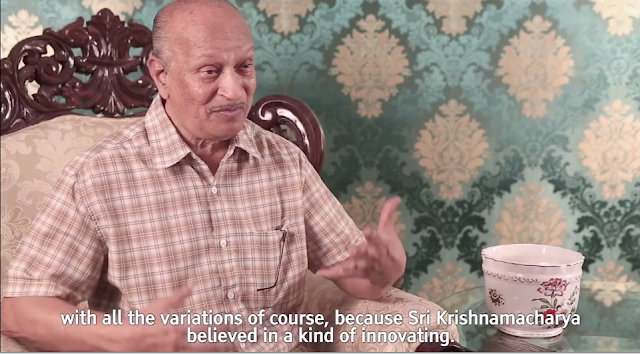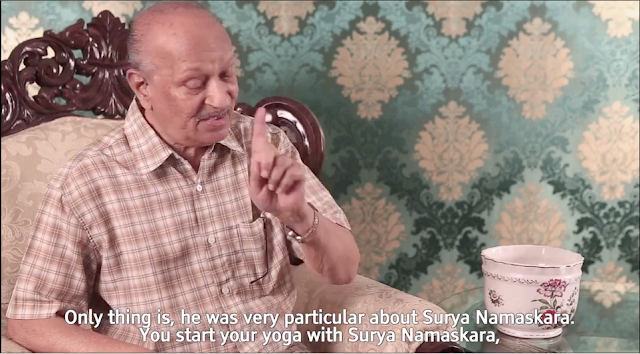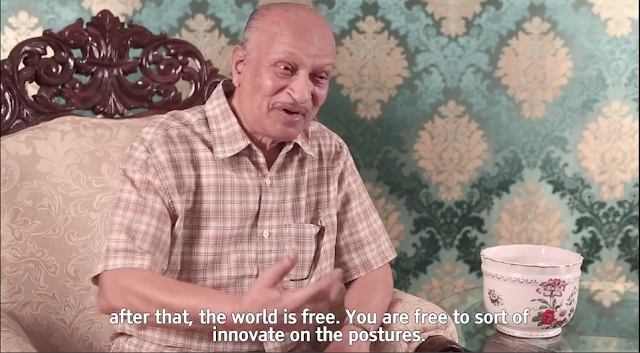| Reposting from this time last year UPDATE Oct 9th 2018 Looking forward to attending this... Mysore Yoga Traditions Retreat and Conference February 8-22 2019 https://www.mysoreyogatraditions.com/mysore-retreat The blog post Includes several 1941 Life magazine photos of T.R.S. SHARMA, one of the boys Krishnamacharya was teaching at the time in Mysore ( Note: 1941 was also the year Krishnamacharya published Yogasanagalu which contains Krishnamacharya's 'Table of Asana', divided into three groups, Primary, Middle, Proficient, which became the Ashtanga sequences we know today http://grimmly2007.blogspot.com/p/yogasanagalu-translation-project.html ). The post also includes a clip and some screen shots of T.R.S. Sharma from the documentary. I'm very much looking forward to meeting him on the retreat. I like the thought of broadening our perspective of Ashtanga vinyasa out from one scene, one teacher, one family to that of Mysore itself, to the practice, practitioners and teachers the city has inspired, to the philosophical traditions from which it derives. This is, for me, personally at least, perhaps a way back to a practice I loved for so long after the upheaval of the last year. It's no coincidence that Ashtanga vinyasa arose in that city and at that time, we can look to the Royal family and their patronage of Krishnamacharya, we can look to the Sanskrit college where Krishnamacharya and later Pattabhi Jois, taught. Ashtangi's know their practice is a Mysore practice but If you practice Iyengar yoga be reminded that Iyengar learned his yoga here, Iyengar yoga is as much Mysore as Pune. The Vinyasa Krama of Ramaswami, Mohan, Desikachar? We can see in Krishnamacharya's inversion vinyasas, in the 1938 Mysore documentary footage, the same vinyasas that these students of Krishnamacharya would later teach (we also see Krishnamachrya practicing Acroyoga with his kids in the same documentary). Attending the retreat (https://www.mysoreyogatraditions.com/mysore-retreat), purchasing (https://www.mysoreyogatraditions.com/purchase) and watching the documentary are two ways to support that work too long neglected by the Ashtanga community, another is to donate directly here https://www.mysoreyogatraditions.com/manuscript-preservation  |
| T.R.S. SHARMA (Mysore 1941), the year Krishnamacharya's Yogasanagalu was published (available HERE) More photos of TRS Sharma's set of photos from the 1941 Life magazine shoot in the appendix as well as a ling to the rest of the photos and magazine article. |
"And by the time I got to 16, I was able to do some 300 asanas with all the variations of course, because Sri krishnamacharya believed in a kind of innovating. There was nothing like a set, fixed kind of postures. So he would not insist that everyone has to follow the same regime, the same series of asana. One thing is , he was very particular about surya namaskara, you start your yoga with surya namaskara, after that the world is free. You are free to sort of innovate on postures. But Surya namaskara is an important thing. IT's kind of an introduction to the entire thing."
T.R.S. SHARMA Mysore Yoga Tradition 2017
 |
| https://www.mysoreyogatraditions.com/ |
This quote by T.R.S. SHARMA in the excellent new documentary Mysore Yoga Traditions, released last month, was a bit of a game changer for me. Up until now I had tended to think that Krishnamacharya was perhaps somewhat dismissive of the practice of Surya namaskara, perhaps considering them little more than a fitness fad of the time (see my earlier post http://grimmly2007.blogspot.jp/2012/05/balasahibs-original-1928-suya-namaskar.html ). And that it was Krishnamacharya's young student Pattabhi Jois (said to have been asked to teach a three or four year course at the Sanskrit college) who added the Surya namaskara's to the beginning of the practice of the asana we find in Krishnamacharya's table of asana (Yogasanagalu (Mysore 1941). That Surya namaskara practice, along with practicing Krishnamacharya's table as fixed series rather than flexible groups that constituted Pattabhi Jois' main contribution to the formation of Ashtanga Vinyasa. I was mistaken, T.R.S. SHARMA is clear, Surya namaskara WAS important for Krishnamacharya. After their inclusion we are free to choose our practice, as well as to innovate, what is appropriate for us that morning. This of course ties in with how Krishnamacharya continued to teach throughout his life, how Ramaswami , who encountered Krishnamacharya soon after the later left Mysore, presents his studies with his teacher.
Note: As much as I love and respect Manju, I strongly disagree with him here when he argues in the movie that it was his father Pattabhi Jois who researched and constructed the sequences of asana that make up Ashtanga Vinyasa. We have Krishnamacharya's table of asana in his Yogasanagalu (Mysore 1941)
http://grimmly2007.blogspot.jp/p/yogasanagalu-translation-project.html, the first two series of Ashtanga closely follow the layout of asana in the table, with only minor reordering. The difference, as T.R.S. Sharma points out, is that for Krishnamacharya the practice of the asana was flexible, for Pattabhi Jois more fixed (See this recent post http://grimmly2007.blogspot.jp/2017/09/manju-jois-new-workshop-video-q-and.html).
Manju stresses that there were originally only three series, Primary, Intermediate and Advanced, I would argue that it is with the advanced asana that Pattabhi Jois had the most input, arranging Krishnamacharya's jumble of proficient group asana into first one series 'Advanced', then two, 'Advanced A and B' and then finally four advanced series 3rd to 6th series (note: We can see most of the Advanced asana found in Ashtanga's 3rd to 6th series demonstrated by Iyengar in the 1938 documentary footage of Krishnamacharya, his family and students).
Of course Pattabhi Jois also mentioned that advanced asana were merely for demonstration, just as Krishnamacharya had suggested they were unnecessary for most but that some should practice them if only for the sake of preservation.
Ashtanga Vinyasa, it's origin and continuation is but one part of the story the documentary Mysore Yoga Traditions has to tell, I strongly recommend watching it, it is no coincidence that Ashtanga vinyasa evolved in Mysore, this is a city that has a long tradition of of investigating, preserving and teaching the history of yoga and it's texts through, among others, the venerable institution of the Sanskrit college and Mysore library.
Below. the trailer for the movie along with some info from the website and some more clips, the
Mysore Yoga Traditions Official Trailer from Dallos Paz on Vimeo.
"Mysore Yoga Traditions! It is a tale to tell. Our original intention was to make a film about the life and teachings of our teacher Sri BNS Iyengar in honor of his 90th birthday. I had been asking for 3 years. But at the last moment, he changed his mind and flatly refused. An important part of his teachings has always been about rejecting fame and fortune, self-promotion and the egotism that goes with it. We knew better than to press the issue. But we went to Mysore anyway to see Guruji and see what would happen with the documentary idea. What happened totally blew our minds! Through luck, chance, good fortune and the tireless efforts of Kanchan Mala we were able to interview Her Royal Highness Sri Satya Pramoda Devi, the Queen of Mysore, as well as Bhashyam Iyengar, the principal of the Maharaja's Sanskrit College in Mysore (the college where Krishnamacharya and Pattabhi Jois taught) several of the professors there including MA Alwar, Gangadhar Bhat, Satya Nariana, Jayashree and Narasimhan of the Ananta Research Institute,TRS Sharma, Yamini Muthana, Sri Laxmi Thathachar the President of the Samskrti Institute, and many others. Guruji finally agreed to an interview in the end - he just didn't want to make a documentary only about himself. Becuase of this our documentary broadened exponentially and we owe it all to him! That level of detachment is why we call him Guruji.
What we came up with was a deep look into the yoga tradition in Mysore, how it has evolved and the philosophy that it rests upon. Our documentary will be an unbiased collection of statements from the intellectual community in Mysore about how they see their own yoga tradition. We were able to ask the questions that have always been in the back of our minds such as....How old is the Ashtanga Vinyasa Yoga we are practicing in the west today and how did it evolve into it's current state? How do they feel about the idea that western exercise systems have influenced it? And how do they feel about the way yoga is being taught and practiced around the world today, among many other topics.
We left Mysore with our hearts full and tears in our eyes at the warmth, generosity, astounding level of knowledge, and deep sincerity of the great men and women we interviewed. We are extremely grateful to all of them! These interviews could never have happened without the help of Kanchan Mala who worked tirelessly to arrange them and convinced people who normally would never be interested in such things to give us interviews.
Also, I have to express my deep gratitude to Dallos Paz, our video man, Joey Paz who did nearly all of the long tedious job of transcribing these interviews, Kelly O'Roke who has been extremely generous and took so many amazing still shots, and Bryce Delbridge who supported all of us with utmost sincerity. Without these beautiful souls, this documentary could never have taken place".
 |
| MYSORE |
Pattabhi Jois: Asthanga finds its Way to the West
Sri K. Pattabhi Jois was certainly the person who communicated Ashtanga Vinyasa Yoga to the west. Without even speaking English fluently, he managed to create huge enthusiasm and dedication in his students. In my eyes, he was a creative genius. He systematized the asanas in a way that made sense and that many people could practice and memorize. To this day, his sequencing and approach is very influential in many forms of yoga throughout the world. His method of teaching turned out some of the finest western practitioners ever, and really ignited a fire in many people. And true to his culture, the way all good Indian teachers do, Sri K. Pattabhi Jois handed all the credit back to his teacher and the tradition that he came from. He never said a word about any of his own contributions.
I think that is where the confusion comes in. He insisted that yoga is ancient, that he was teaching a good method, and that his students should stick to it. What’s wrong with that? There is a lot of humbleness and dedication expressed there. To me, it is endearing! Especially in the yoga scene of today where everyone is trying so hard to think of any possible new twist to put on yoga. The moment anyone thinks of a good idea to add to yoga, they will usually try to brand it, copyright it, and take it to the bank! We have every kind of yoga imaginable now. We are so attached to the material aspects of the practice that we miss the point of the whole thing. We bicker and quarrel about asana sequences that are very modern in light of yoga’s long history, and fail to see the deep, beautiful community and culture that gave them to us.
As David Williams used to say “Before practice the theory is useless, and after practice the theory is obvious.” Theory and practice: “Before practice the theory is useless, and after practice the theory is obvious.”
'Never changed anything' (said to be Krishnamacharya and Pattabhi Jois's reply when asked about the 'system they taught): Why does every teacher insist on having been giving precisely this sequence from his teacher, who received it from his teacher (and from his teacher and from his teacher…)?
Not every teacher does. My teacher, Sri BNS Iyengar, who just turned 90, teaches a slightly different sequence of Ashtanga Vinyasa Yoga. He can be very innovative when working with advanced students. In fact, no two teachers teach every nuance of yoga exactly the same. No matter how hard we try, it is impossible. I think there is a good reason for fixed sequences. Having an underlying system in common is a brilliant thing and has had a very positive impact on yoga, in my view. The fixed sequences are like the scales a classically trained musician must learn. Anyone trained in the Ashtanga sequences of Sri K. Pattabhi Jois or Sri BNS Iyengar has a particular grace and competency gained through repetition of movement that is very noticeable. I think Sri K. Pattabhi Jois may have made a bigger contribution than anyone else in this regard. When the sequences are fixed, the practice becomes much more concentrated and the standard goes up exponentially.
So in my view, the asanas we are practicing do come from a long tradition. And the yoga community they come from is very old indeed. They just happen to be a little more recently formatted than we would have liked to think. Yoga has been around forever and taken many forms.
Appendix
Here are some screenshots of the scene with T.R.S. SHARMA quoted above.
A short introduction to TRS Sharma from a recent workshop
"Ashtanga Yoga Studio is very honored to host a Skype lecture with TRS Sharma! This is an amazing opportunity to hear the thoughts and views of someone who studied extensively with T. Krishnamacharya during his early days in Mysore. TRS Sharma began to practice yoga with Krishnamacharya at the age of 12. Krishnamacharya is considered by many to be the father of modern yoga. Mr. Sharma grew up in the heart of the yoga tradition in Mysore. He comes from a long line of Sanskrit scholars and priests. Experts are now saying that at least half of the yoga postures practiced outside of India have been directly influenced by Krishnamacharya. Because he was educated in America, Mr. Sharma has a unique insight a very articulate view of how yoga has unfolded into Western culture. Mr. Sharma is particularly interested in the way Indian and Western culture have blended together, and the parallels as well as the stark differences in our views. He will be speaking about the history of the yoga we are practicing today, as well as the cultural and philosophical background that it has come from. There will be time for questions and answers at the end.
Have you have ever been curious about the origins yoga we are practicing today? Just who are the keepers of this knowledge? What do they think about the way we practice yoga today? Mysore holds those secrets. This is a rare and special opportunity!
Everyone is welcome!"
https://www.ashtangayoga.info/ashtangayoga/tradition/170314-tradition-vs-innovation/
More photos from the Life magazine photo shoot, see this post for the full series of photos of Krishnamacharya's students. http://grimmly2007.blogspot.jp/2017/02/krishnamacharyas-mysore-yoga-students.html
*
Set 3
T R S Sharma
Note: TRS Sharma is interviewed in the upcoming documentary
'The Mysore Yoga Tradition', see at 1:48 in the movie's trailer
at the end of post.
I like the thought of broadening our perspective of Ashtanga from one scene, one teacher, one family to that of Mysore itself. It's no coincidence that Ashtanga vinyasa arose in that city and at that time, we can look to the Royal family and their patronage of Krishnamacharya, we can look to the Sanskrit college where Krishnamacharya and later Pattabhi Jois, taught. We can also make ourselves more aware of the great work being done in Mysore to preserve ancient texts and palm leaf manuscripts. If the fabled Yoga Korunta ever existed, these may well be the people to discover, digitise, translate and preserve....., as well as other equally fabulous works.
Preserving palm leaf manuscripts
*













